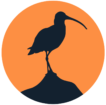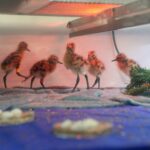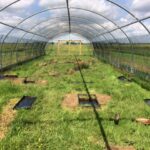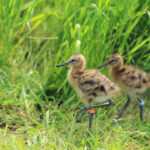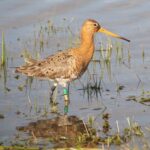What is headstarting?
Headstarting is one of the techniques used by conservationists to boost the populations of endangered species. It’s typically done with birds, but can be used for other groups of animals such as amphibians, reptiles and fish.
Headstarting typically involves taking wild eggs from bird nests and hatching them in captivity. These chicks are then released into the wild when they are ready to fledge, and are sometimes referred to as ‘recruits’ in discussions about headstarting.
Taking away the wild eggs can prompt the parent birds to lay a second clutch, which are left to be brought up in the wild.
Headstarting can have its difficulties. For species where the young imprint on the adults, the aviculturists must make sure that the chicks do not see humans as their parents. Instead, the aviculturists disguise themselves to look like adult birds. Some species require hand-feeding from their ‘parents’ for a while, whereas others are independent and able to feed quickly after hatching.
The headstarting technique takes a lot of time, money and human resources to implement, so it is not widely used except for species where it could really make a difference to their populations.
Why use headstarting?
This technique is used to reduce the number of fatalities suffered by wild bird eggs and chicks, such as starvation, flooding and predation.
By bringing the eggs into captivity, the eggs and chicks can be artificially protected during this vulnerable stage in the lifecycle and be released back into the wild after a few months.
Though they will still face other threats once released, it gives the chicks an opportunity to make it through this very difficult time period.
Headstarting and Eurasian Cranes
After a 400 year absence as a breeding bird in the UK, some Eurasian Cranes (also known as Common Cranes) re-established a small breeding population in Norfolk in the late 1970s, which has gradually grown since.
Then in 2009, the Great Crane Project was set up by the Royal Society for the Protection of Birds (RSPB), the Wildfowl and Wetlands Trust (WWT), Pensthorpe Conservation Trust and Viridor Credits Environmental Company to reintroduce the species to Somerset, using eggs brought over from Germany.
Across five years between 2010 and 2014, 93 birds were released in total after being hand-reared at WWT Slimbridge Wetland Centre in Gloucestershire. Once they reached maturity, some of them began pairing up and breeding. 18 wild-born chicks fledged in 2022, although four of these did not survive through to the end of the year.
Headstarting and Spoon-billed Sandpipers
One of the most iconic endangered birds is the Spoon-billed Sandpiper, named for its spoon-shaped bill and nicknamed the “spoonie”. This tiny wader breeds in Russia, and spends the winter in South Asia. The species is listed as Critically Endangered on the IUCN Red List and it’s thought that there are fewer than 800 birds. A captive flock was established at WWT Slimbridge in 2011, following fears that the species was on the brink of extinction, which is referred to as an “ark” population.
In addition to the captive breeding flock at WWT Slimbridge, headstarting has been undertaken in Russia since 2012 to boost the population of wild birds. More than 200 headstarted birds have been released between 2012 and 2022, roughly a quarter of which have been resighted in the wild and some have returned to breed.
The captive breeding and headstarting have been accompanied by a variety of other conservation methods to improve understanding of the species’ behaviour, to raise awareness of the species and its plight, and to protect habitats that the species uses.
A scientific paper published in Biodiversity and Ecology Research in Russia: Recent Advances and Future Trends in early 2023 reported on the impact of headstarting Spoon-billed Sandpipers at Meinypil’gyno village in Chukotka, Russia.
Headstarting and Black-tailed Godwits
There are two subspecies of Black-tailed Godwit that can be found in the UK. The limosa subspecies breeds in East Anglia, whilst smaller numbers of the islandica subspecies breed in Scotland. Those that winter in the UK are generally from the islandica subspecies breeding in Iceland.
Once a common breeding bird in the UK, the limosa Black-tailed Godwit subspecies actually became extinct as a regular breeding bird here during the 19th century, due to habitat loss and degradation, and perhaps exacerbated by hunting and egg collection.
However, they reappeared during the 1930s, with a peak of 65 breeding pairs on the Ouse in the 1970s. Numbers dropped after this due to spring floods and predation.
In recent years, a collaboration between the RSPB and WWT was set up called Project Godwit (an EU LIFE project) which focused on the conservation of Black-tailed Godwits at the Ouse Washes and Nene Washes. Part of this project involved trialling headstarting – collecting eggs from the RSPB Nene Washes under licence from Natural England, hatching and rearing the chicks at WWT Welney Wetland Centre, and releasing fledglings back into the wild once they were able to fly.
Across five years of the trial, 206 headstarted birds were released into the wild. Over 50% of breeding pairs in the Fens now consist of either one or two headstarted birds, and the population on the Ouse Washes has increased from three pairs in 2017 to over 18 pairs in 2023.
“The headstarting trial has been a success,” says Will Costa, WWT’s project manager and lead aviculturist for Project Godwit. “Released birds are migrating at the right times to the right locations – we’ve received sightings from known godwit sites throughout the flyway, including from as far south as Senegal and we also have geolocator data from a number of birds. Altogether, birds have been recorded in 10 countries outside the UK. And importantly, they’re also surviving and returning to the Fens to breed at levels similar to wild-reared birds.”
“Headstarting has achieved the population boost at the Ouse Washes that we hoped it would,” adds Rebecca, the RSPB project manager. “It’s a relatively short-term measure however and unfortunately despite our best efforts, predation of eggs and chicks in the wild is still too high for the population to survive without further intervention. New measures are underway at breeding sites to address this but for long-term recovery, we need measures in the wider landscape – bigger, better and more connected wetlands and conditions that allow both predators and prey to thrive.”
“We are producing a 10-year action plan which, among other things, calls for research into the predator issue and the provision of more wet grassland in the Fens and elsewhere. Headstarting may also be required again and we are currently working on a feasibility study that’s looking at what future role headstarting could play in godwit conservation.”
Headstarting and Eurasian Curlews
Which brings us on to Curlews and headstarting. It’s believed that there are 58,500 breeding pairs of Curlews in the UK, which may sound like a lot compared to the species covered above, but it’s thought that Curlews are producing an estimated 10,000 too few fledged youngsters each year to maintain their population. Headstarting 10,000 eggs is not feasible, but perhaps a contribution to that amount can be part of a wider conservation plan.
All the released birds have been fitted with coloured and numbered rings so that they can be identified at a distance and reported back to the project. Although each combination in unique, it can still be tricky to read the numbered rings.
In addition to the colour ringing, some of the released Curlews are also radio-tagged or GPS-tagged, which provides detailed information on how the birds are using the habitats and their migration routes.
Graham Appleton’s Wader Tales blog post from August 2022 takes a look at some of the information being gathered by the British Trust for Ornithology (BTO) from satellite-tagged birds, and what this information means to conservationists.
Where are headstarted Curlews being released?
Headstarting Curlews was first kicked off by the team at Curlew Country in 2017, which is working to conserve the species in the Shropshire hills and Powys borders. The team at Curlew Country decided to start headstarting Curlews after the project had been monitoring wild Curlew nests for two years and found that none successfully fledged chicks. Drastic action was needed. Initially, the birds were headstarted by Curlew Country, but the collected eggs are now looked after at WWT Slimbridge. In 2019, the first headstarted bird returned to breed and more headstarted birds have returned since.
A large headstarting project has been initiated by Natural England in 2019, which draws upon the learnings of the Curlew Country team and makes use of Curlew eggs laid on RAF airfields. These eggs would otherwise be destroyed as Curlews are considered a risk to aircraft, but Graham Irving from Natural England saw an opportunity to help Curlews.
At the start of the project, the eggs were hatched at WWT Slimbridge and fifty Curlews were released into the Severn and Avon Vale project area. After a hiatus in 2020, a number of headstarting projects got underway, increasing year on year, including at Pensthorpe in Norfolk where the birds are released at various sites in North Norfolk, including Wild Ken Hill (recently the home of the popular BBC Two Springwatch programme) and the Sandringham Estate.
Some of the headstarted chicks from WWT Slimbridge have also been released in Dartmoor as part of the Dartmoor Curlew Recovery Project, with 33 released in 2021 and 27 in 2022. This headstarting has been part of a wider conservation project called the Farming in Protected Landscapes programme which aims to improve habitats in Dartmoor to help species such as Curlew, Snipe and Lapwing.
In 2023, headstarted curlews will be released onto Elmley Nature Reserve on the Isle of Sheppey in Kent.
Typically birds are released into areas where there are existing robust Curlew populations, however headstarting is also being used to encourage new populations in sites where there is no record of breeding Curlew.
Curlew Headstarting webinar
In March 2022, Curlew Action hosted an online webinar on headstarting. As with all of Curlew Action's webinars, the recording is available to view on our YouTube channel.
